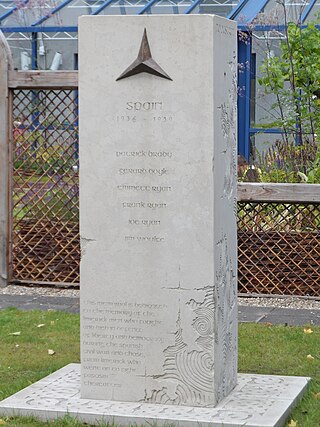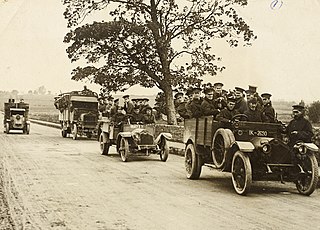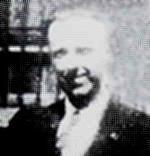Related Research Articles

The Irish Army, known simply as the Army, is the land component of the Defence Forces of Ireland. Approximately 7,300 people served in the Irish Army on a permanent basis as of May 2016, and there were 1,600 active reservists, divided into two geographically organised brigades. By late September 2020, this had reduced to 6,878 permanent army personnel.

The Essex Regiment was a line infantry regiment of the British Army in existence from 1881 to 1958. The regiment served in many conflicts such as the Second Boer War and both World War I and World War II, serving with distinction in all three. It was formed in 1881 under the Childers Reforms by the amalgamation of the 44th Regiment of Foot and the 56th Regiment of Foot.

The Dorset Regiment was a line infantry regiment of the British Army in existence from 1881 to 1958, being the county regiment of Dorset. Until 1951, it was formally called the Dorsetshire Regiment, although usually known as "The Dorsets". In 1958, after service in the Second Boer War along with World War I and World War II, the Dorset Regiment was amalgamated with the Devonshire Regiment to form the Devonshire and Dorset Regiment. In 2007, it was amalgamated with the Royal Gloucestershire, Berkshire and Wiltshire Regiment, The Light Infantry and the Royal Green Jackets to form a new large regiment, The Rifles.

The Royal Warwickshire Regiment, previously titled the 6th Regiment of Foot, was a line infantry regiment of the British Army in continuous existence for 283 years. The regiment saw service in many conflicts and wars, including the Second Boer War and both the First and Second World Wars. On 1 May 1963, the regiment was re-titled, for the final time, as the Royal Warwickshire Fusiliers and became part of the Fusilier Brigade.

The Royal Northumberland Fusiliers was an infantry regiment of the British Army. Raised in 1674 as one of three 'English' units in the Dutch Anglo-Scots Brigade, it accompanied William III to England in the November 1688 Glorious Revolution and became part of the English establishment in 1689.

The Connolly Column was the name given to a group of Irish republican socialist volunteers who fought for the Second Spanish Republic in the International Brigades during the Spanish Civil War. They were named after James Connolly, the executed leader of the Irish Citizen Army. They were a company-strength unit of the XV International Brigade, which also included the US, British and Latin American battalions in Spain. The name is now retroactively applied to all Irish volunteers who fought for the Spanish Republic.

The King's Shropshire Light Infantry (KSLI) was a light infantry regiment of the British Army, formed in the Childers Reforms of 1881, but with antecedents dating back to 1755. It served in the Second Boer War, World War I and World War II. In 1968, the four regiments of the Light Infantry Brigade amalgamated to form The Light Infantry, with the 1st KSLI being redesignated as the 3rd Battalion of the new regiment.

This is a timeline of the Irish War of Independence of 1919–21. The Irish War of Independence was a guerrilla conflict and most of the fighting was conducted on a small scale by the standards of conventional warfare.

Seán Hogan was one of the leaders of the 3rd Tipperary Brigade of the Irish Republican Army during the War of Independence.
The Irish military diaspora refers to the many people of either Irish birth or extraction who have served in overseas military forces, regardless of rank, duration of service, or success.

Tommy McKearney is a former Irish volunteer in the Provisional Irish Republican Army who took part in the 1980 hunger strike.
The 168th Brigade was an infantry brigade formation of the British Army that saw service during both the First and the Second World Wars. Throughout its existence, serving under many different titles and designations, the brigade was an integral part of the 56th (London) Infantry Division. It served on the Western Front during First World War and in the Italian Campaign during the Second World War. It was finally disbanded in the 1960s.

Cornelius McNamara, better known as Connie (Mackey) Mc Namara, was the Captain of "A" Company Active Service Unit of the Second Battalion Mid Limerick Brigade in the Irish Republican Army during the Irish War of Independence.

Edmond Foley, sometimes known as Edmund or Edward, was a member of the Irish Republican Army (IRA) who was hanged in Mountjoy Prison on 7 June 1921. Together with nine other men executed by hanging during the War of Independence, he was one of The Forgotten Ten.
The Dromkeen ambush took place on 3 February 1921, during the Irish War of Independence, at Dromkeen in County Limerick. The Irish Republican Army (IRA) ambushed a Royal Irish Constabulary (RIC) patrol, killing 11 policemen.
Sean C. Finn was a commander of multiple units in the IRA's Irish War of Independence in the early 20th century. He led many attacks on the Black and Tans and the heavily-armed RIC patrols, with his brigade usually armed only with shotguns.
Major-General Cuthbert Henry Tindall Lucas, was a British Army officer who commanded the 4th Division during the final months of World War I, and also served in the Second Boer War and the Irish War of Independence, during which he was captured by the Irish Republican Army (IRA).

On 25 May 1921, during the Irish War of Independence, the Custom House in Dublin was occupied and then burnt in an operation by the Irish Republican Army (IRA). The Custom House was the headquarters of the Local Government Board for Ireland, an agency of the British administration in Ireland, against which the IRA was fighting in the name of the self-proclaimed Irish Republic. The operation, involving over 100 IRA volunteers, was a propaganda coup for the republicans but a military disaster for the IRA in the Irish capital. A force of British Auxiliaries quickly arrived and a gun battle erupted. Five IRA volunteers were killed, along with three civilians, and about 80 volunteers were captured.
On 13 May 1919, a captured Irish Republican Army (IRA) member, Seán Hogan, was rescued from a train by his comrades while being guarded by four armed Royal Irish Constabulary (RIC) officers. Two of the RIC officers were killed and several IRA volunteers were wounded. The rescue took place on Hogan's 18th birthday, while the Cork-bound train stopped at Knocklong station in County Limerick. It was undertaken by three of Hogan's comrades from the 3rd Tipperary Brigade of the IRA and five members of the Galtee Battalion of the East Limerick Brigade. Hogan was one of the most wanted men in Ireland at the time of his rescue, due to his role in the Soloheadbeg ambush and would almost certainly have been executed.
Robert "Bobby" Byrne was an Irish trade unionist, Republican and member of the IRA. He was the first Irish Republican that was killed in the Irish War of Independence.
References
- ↑ McGreevy, Ronan. "Shooting dead of IRA volunteer instigated general strike against British rule". The Irish Times. Retrieved 19 May 2022.
- ↑ admin. "Captain Cornelius McNamara of 'A' Company, 2nd Battalion, Mid-Limerick Brigade,Irish Volunteers IRA". Irish Volunteers.org. Retrieved 19 May 2022.
- ↑ Lantry, Margaret (30 March 2022). "Mass IRA grave a compelling element of UCC's architectural heritage". Irish Examiner. Retrieved 19 May 2022.